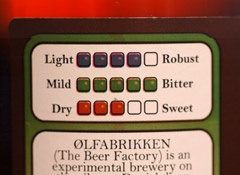 This is just a great idea from Ølfabrikken, or maybe from Shelton Brothers, which imports the Danish beer.
This is just a great idea from Ølfabrikken, or maybe from Shelton Brothers, which imports the Danish beer.
I want to see similar information on the label of every beer in the store.
What else do you need to know?
OK, if 100 gram IPA is any good (yes) and if it is worth $8.99 (in New Mexico; well that’s $4 more than Stone Ruination). And maybe they need a fourth scale – either ranging from “beginner” to “experienced” (my idea of bitter might be different than some) or “bland” to “intense.” In either case all the blocks would be filled in for 100 gram.
But wouldn’t you love to see a similar chart — like brewing competitors would every come up with a standard — on the back of very bottle?
The label also provides a little information about the brewery, and the fact its beers are unpasteurized, unfiltered and naturally carbonated.
And about the beer itself: “Our 100 Gram IPA is an Imperial IPA, hopped continuously throughout the entire boil. Hops additions are made every three minutes, and are increased by 100 grams with each addition. The result is a flavorful bitter ale, with intense floral aromas from the huge quantities of hops added near the end of the boil.”
While I love the informative label and that beer drinkers in Denmark can enjoy locally brewed Double IPAs I’m still trying to figure out why it is necessary to ship the hops back to the United States.
I love the “beginner to experienced” idea. Could it be complex to simple (or a non-pejorative for simple). How about “hearty to subtle” too?
Yes, I agree with you Stan – that’s great. Over here in England, CAMRA are promoting something similar called “Cyclops”. I think it was devised by Everard’s, small regional brewer. It doesn’t have half the simplicity and effect as this effort though.
I like it as well. If I were to add anything, it’d be a note on the origin of the hops. I enjoy and appreciate American hops, but prefer English. If I pick up a beer I’ve never had without having done a touch of research, I’m disappointed to have American hops in a Russian Imperial Stout or Scottish ale. At least with pale ales these days, one more and more sees “American Pale Ale” printed, which tells me if it’s the beer I’m in the mood for or not.
I love the ratings scales on the Ølfabrikken. Very helpful.
I’m not so crazy about the “beginner to experienced” scale idea. It’s too subjective, and I think it could end up damaging the reputations of a lot of great beers.
Who wants to be spotted drinking a “beginner beer?”
When are you going to stop sucking on the Marzen teat and step up to a real man’s beer, like this Thunderballs Imperial Baltic Uber Porter… it’s brewed with horseradish and 20 kinds of hops!
On a similar note, I hate the marketing phrase “entry-level.” I’ve been looking for a new car and I am considering a very small, very fuel efficient model for daily commuting. But all of the small cars are labeled “entry-level,” as if only first-time car buyers should be interested.
Well, I’m a fourth-time car buyer, and I’m interested in one of those little clown cars, but I’m so vain that the “entry-level” moniker has me looking two or three models up… (maybe that’s the plan…)
Now even the “mid-size sedan” sounds kind of wimpy…
Eric – I started to make some suggestions right after Alan comment, but then came Stonch’s and I realized one of the strength’s of the Ølfabrikken labels is simplicity.
The one addition I would consider is an intensity scale (whatever the friendly opposite of intensity is – not bland). The reason being that you see a lot of experts, Garrett Oliver surely was one of the first in a beer context, talk about the value of considering the intensity levels when pairing beer and food.